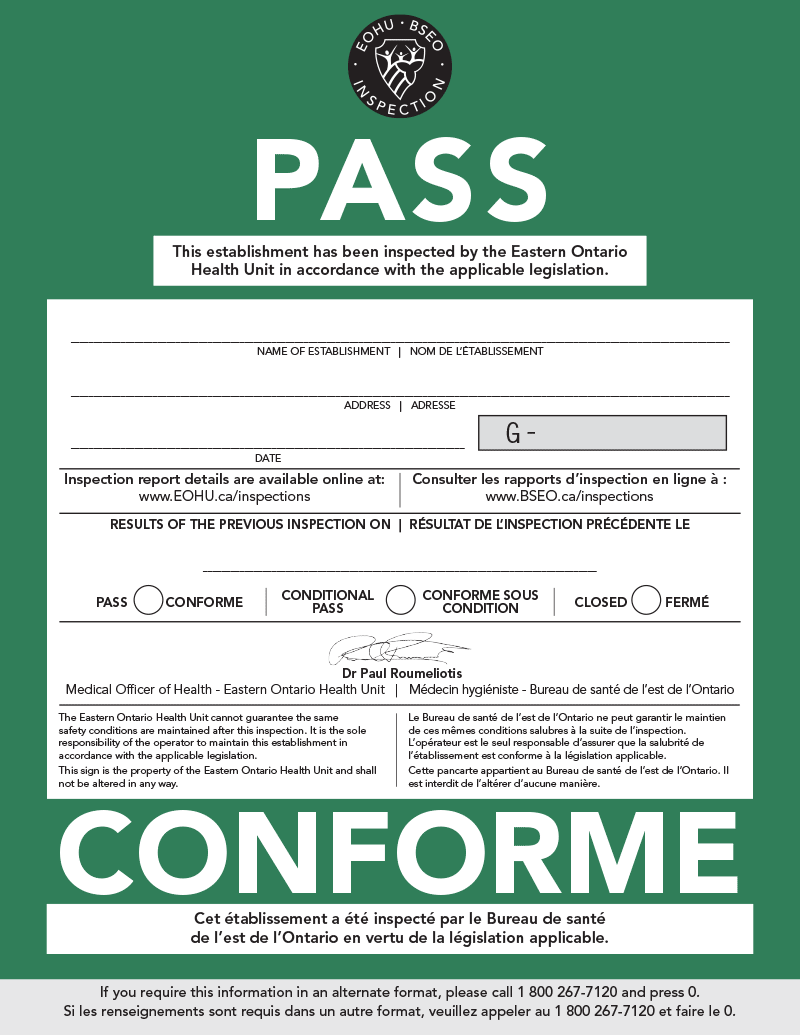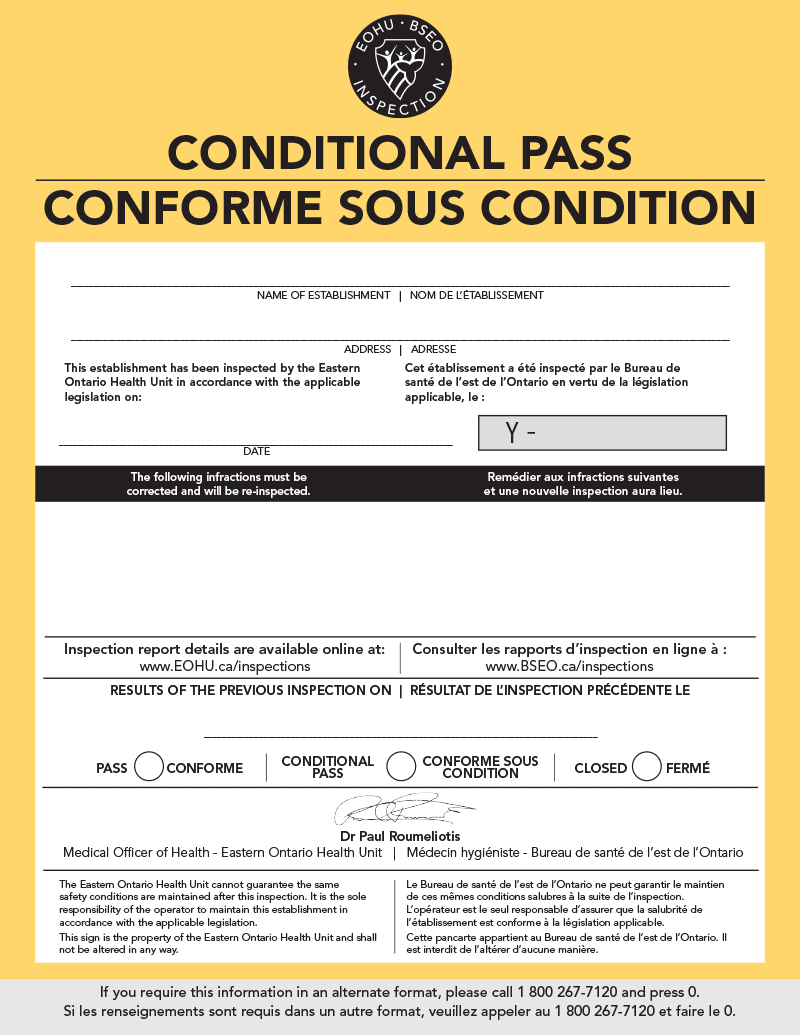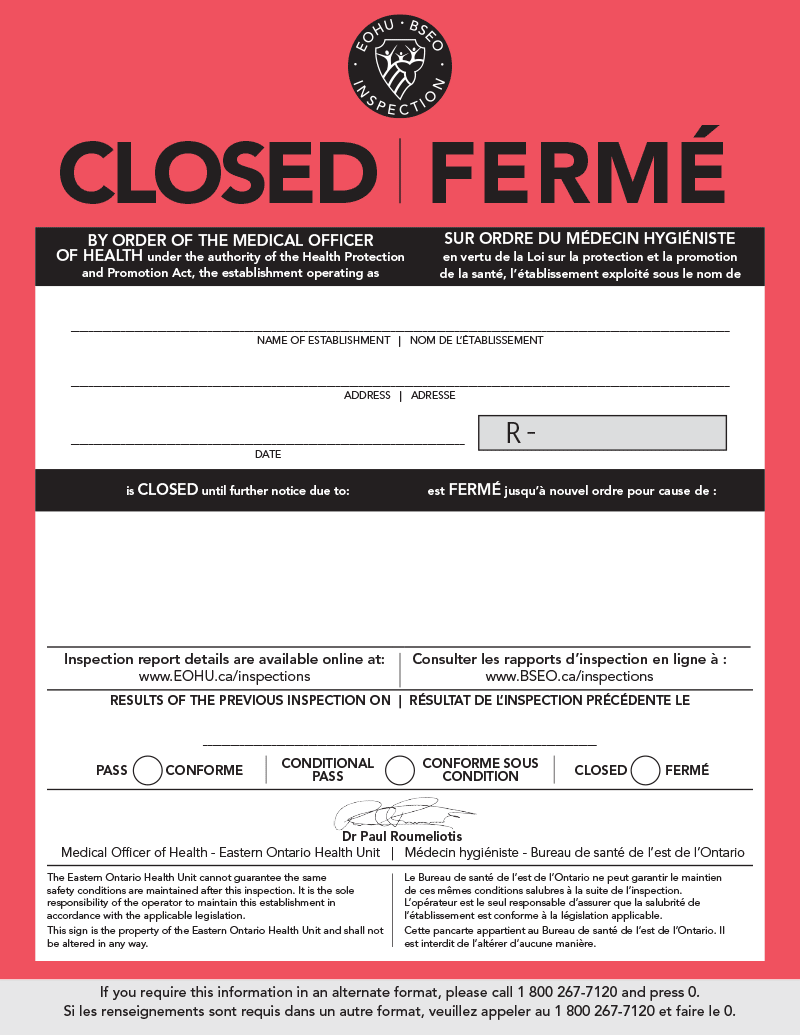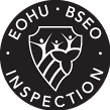Overview of the Disclosure System
Responsibility for retail food safety
All food business premises must operate according to the minimum requirements of the Ontario Food Premises Regulation (O. Reg. 493/17) under the Health Protection and Promotion Act. It is the responsibility of food business operators to know and comply with the regulation at all times. Public Health Inspectors regularly inspect food business premises to assess if they are being operated according to the requirements in the regulation.
The EOHU encourages all operators of food business premises to thoroughly review this Guide and the Food Operators Checklist. It is important that you understand and follow the requirements of the Ontario Food Premises Regulation (O. Reg. 493/17).
Why is a Food Premises Disclosure System needed?
The system has many benefits for the public and food business operators. It is intended to improve food safety standards, reduce the risk of foodborne illness, and raise consumer awareness of food safety. For these reasons, it is required by law under the Ontario Food Premises Regulation (O. Reg. 493/17).
Research has demonstrated that disclosure systems improve compliance with food safety legislation and enhance food safety standards in retail food premises.
How does the Food Premises Disclosure System work?
This system applies to food business premises operating within the EOHU catchment area. The system requires the posting of a green, yellow or red sign based on the results of the most recent food safety inspection.
The Food Premises Disclosure System is based on compliance with the Ontario Food Premises Regulation (O. Reg. 493/17) which sets a minimum objective standard by which to measure performance. While compliance with the regulation is a measure of the risk of foodborne illness, one food handling mistake in even the best operated food premises can lead to foodborne illness. The operator of every food business premises is responsible for knowing the risks associated with foodborne illness and for taking action in his or her premises to minimize these risks.
When a Public Health Inspector visits your premises, he/she will assess if your operation meets the requirements of the Ontario Food Premises Regulation and then complete a food safety inspection report.
The disclosure system is designed to provide information to the public on inspection results. Currently, a summary of the inspection findings, charges and convictions for all food business premises in the EOHU region is available online at www.eohu.ca/inspections.
When a Public Health Inspector visits your establishment, you will receive one of three colour-coded EOHU Inspection signs.
The signs provide a summary of inspection results, and are colour-coded to indicate the following:
- Pass ( GREEN ) – Full or substantial compliance with the Ontario Food Premises Regulation 493/17.
- Conditional Pass ( YELLOW ) - Significant non-compliance with the Ontario Food Premises Regulation 493/17 which may affect food safety (immediate threats to food safety must be eliminated at the time of inspection and will be assessed again).
- Closed ( RED ) - Immediate health hazard to the general public.
The EOHU provides a sign holder for every food premises, on a one-time basis. The Public Health Inspector will post the sign near the main public entrance to the premises. It is an offence under the legislation to remove, alter or obstruct the sign or to render it not clearly visible in any way. Signs are the property of the EOHU; the Public Health Inspector will collect the old sign when a new one is provided or when the premises closes. In the event that the sign is damaged or goes missing, the operator must notify the EOHU immediately and a sign may be re-issued. Operating without a sign may result in a legal action.
Infractions: critical vs. non-critical
Each infraction of the Ontario Food Premises Regulation 493/17 is categorized as either critical or non-critical.
Critical infractions are infractions that have the potential to pose an immediate public health risk and/or lead to a health hazard (e.g. improper cold/hot holding temperatures).
Non-critical items are infractions that do not pose an immediate health risk, and by themselves are not likely to lead to a foodborne illness, and/or do not relate directly to food handling practices (e.g. structural design of floors or walls).
Correction of infractions and legal action
When infractions are observed in a food premises, it is the responsibility of the operator to ensure that they are corrected as soon as possible. Items directly related to food safety must be corrected by the operator at the time of inspection and will be assessed again during a re-inspection. There is no fee for inspections; however, non-compliance may result in legal action being initiated, which can result in fines.
Public Health Inspectors at the Eastern Ontario Health Unit are designated Provincial Offences Officers. This means that they have the authority to issue offence notices, i.e. tickets or summonses when infractions are observed.
Frequency of inspections
Public Health Inspectors are required to complete a risk assessment of all food premises at least once per year to determine the frequency of inspections. Inspections may be conducted once, twice or three times a year, or in certain cases once every two years, depending on the factors listed below.
A) Three inspections per year
Food premises receiving at least three inspections per year include full-menu premises with the following characteristics:
- Daily preparation of large volumes of hazardous foods.
- Preparation of foods that involve multiple preparation steps (e.g. defrosting, cooking, cooling, storing, reheating, preparing, hot holding, slicing, de-boning, mixing, serving).
- Premises associated in the past with foodborne illness.
- Premises serving high-risk populations, such as hospitals, daycares, etc.
- Premises with a poor compliance history.
B) Two inspections per year
Food premises receiving at least two inspections per year include those that:
- Prepare hazardous foods without meeting the criteria outlined in A above, or
- Prepare non-hazardous foods with extensive handling and/or high volume of patrons.
C) One inspection per year
Food premises receiving at least one inspection per year include those that:
- Serve prepackaged hazardous foods, or
- Prepare and/or serve non-hazardous foods without meeting the criteria outlined in B above, or
- Are a food storage facility for non-hazardous foods only, and/or
- Have public health concerns that relate primarily to sanitation and maintenance.
D) One inspection every two years
- Premises that carry only pre-packaged non-hazardous foods.
In any of these categories, additional inspections may be conducted as necessary.
PASS (GREEN) SIGN

What does it mean?
A PASS sign posted at the entrance of a food business premises indicates full or substantial compliance with the requirements of the Ontario Food Premises Regulation (O. Reg. 493/17) was observed on the inspection date noted on the sign.
What does substantial compliance mean?
Substantial compliance with the Ontario Food Premises Regulation means that:
- Minimum standards of the Ontario Food Premises Regulation have been met.
- Fewer than three non-critical infractions were noted, or infractions noted were corrected during the inspection.
- Food operation is unlikely to cause an immediate risk to public health.
- Correction of any infractions noted is the responsibility of the operator and must be made as soon as possible.
Examples of minor infractions
- Walls or floors in areas where food is not stored or handled need minor repairs.
- No test kit or supply of test strips to check the sanitizer concentration in automatic dishwashers is available.
- No thermometers were found in refrigerators/freezers.
When would my premises be re-inspected?
Follow-up inspections will take place at the discretion of the Public Health Inspector. Minor non-compliance observed in a premises receiving a PASS sign can often be followed up during the next regular inspection.
What type of legal action can be expected?
The appropriate legal action will be initiated at the discretion of the Public Health Inspector. Minor infractions, especially those seen repetitively or frequently, may result in the issuance of Provincial Offence Notices (tickets).
CONDITIONAL PASS (YELLOW) SIGN

What does it mean?
A CONDITIONAL PASS sign will be issued when significant non-compliance with the Ontario Food Premises Regulation (O. Reg. 493/17) is observed during an inspection. To avoid a closure order being issued, immediate threats to food safety must be addressed to the satisfaction of the Public Health Inspector during the inspection. A CONDITIONAL PASS indicates that the premises may not be operating according to the Ontario Food Premises Regulation in between inspections.
What does significant non-compliance mean?
Significant non-compliance with the Food Premises Regulation means that your premises has:
- Three or more non-critical infractions.
- One or more critical infraction(s).
- Repeated one or two infractions.
Examples of critical infractions that can lead to foodborne illness:
- Hazardous foods (i.e. meat, poultry, fish, shellfish) are not cooked to the internal temperature required to kill potentially harmful bacteria.
- Hazardous foods are not stored at 4ºC or colder to prevent the growth of harmful bacteria.
- Contamination of ready-to-eat foods with raw foods/chemicals/pesticides.
- Food handling staff not washing their hands prior to handling food.
- There is potential for food contamination due to the premises being infested by insects or rodents.
- The same cutting board is used for raw food (e.g. chicken, beef, fish) and for ready-to-eat food (fruit, vegetables, salads) without being washed, rinsed and sanitized in between processes.
When will my food premises be re-inspected?
Items that pose an immediate risk of foodborne illness must be corrected at the time of inspection. In addition, a food premises receiving a yellow CONDITIONAL PASS sign will receive a follow-up inspection.
Based on the findings of the follow-up inspection, the Public Health Inspector will issue the appropriate sign for the premises. If the infractions have not been corrected, another yellow CONDITIONAL PASS sign will be issued, and a follow-up inspection will be conducted at the discretion of the Inspector.
What type of legal action can be expected?
When a food premises has infractions that lead to the issuance of a yellow CONDITIONAL PASS sign, the Public Health Inspector may initiate legal action with Provincial Offence Notices (tickets). Crucial infractions with potential to pose an immediate public health risk and/or lead to a health hazard will result in the closure of the food business premises.
CLOSED (RED) SIGN

What does it mean?
A red CLOSED sign is issued to the operator of a food premises when the Public Health Inspector is of the opinion, upon reasonable and probable grounds, that an immediate health hazard exists.
Under these conditions, an order to close the premises under Section 13 of the Health Protection and Promotion Act will be issued. A Section 13 order is issued to eliminate or decrease the effect of the health hazard. An order is a legal document. Failing to comply with an order is an offence, which upon conviction, could result in a significant fine.
What happens after my food premises gets a CLOSED sign?
If a food premises is issued a CLOSED sign, the operator must do the following:
- Close the food premises and stop preparing and selling food to the public.
- Correct the conditions listed on the closure order to remove the health hazard(s).
- Contact the EOHU for a follow-up inspection when the conditions have been removed or corrected. A follow-up inspection must be conducted prior to re-opening the premises.
A Public Health Inspector will rescind the order and remove the CLOSED sign if the health hazard(s) have been removed or corrected. Observations made during the follow-up inspection will determine the appropriate sign for the premises.
Examples of infractions leading to a CLOSED sign:
A health hazard can be any condition that will likely lead to foodborne illness if the condition is not corrected. Examples include:
- Premises infested with insects or rodents, where there is evidence of food contamination and a lack of an effective pest control program to remove the infestation.
- Lack of sufficient potable water to operate the food premises in a sanitary manner.
- Sewage back-up into food preparation or storage areas.
- Too many infractions that cannot be corrected while the premises is in operation.
When will my premises be re-inspected?
The CLOSED premises will be monitored at all times to ensure that the premises remains closed. The operator may contact the EOHU to request a re-inspection. The operator is responsible for keeping the premises closed. The CLOSED sign will remain posted until a Public Health Inspector issues the appropriate replacement sign based on a follow-up inspection. If the infractions have not been corrected, the CLOSED sign will not be removed, and the premises must remain closed.
What type of legal action can be expected?
When conditions observed at a food premises constitute an immediate health hazard the operator may be charged. Furthermore, operators who do not comply with a closure order will be charged and summonsed to appear in court.
If the court finds the defendant guilty, an individual operator may be fined up to $5,000, and a corporation up to $25,000, for each day or part of a day on which the offence occurred or continued to occur.
Food Handler Certification Program
The Ontario Ministry of Health and Long-Term Care has recently changed the Ontario Food Premises Regulation to require food premises to have at least one certified food handler on site when food is being handled or served.
The EOHU strongly recommends that managers and staff involved in food preparation complete food safety training through the Food Handler Certification Program.
Topics covered in the training program include:
- Food safety legislation
- Introduction to food safety, microorganisms and contamination
- Cross-contamination
- Understanding foodborne illness
- Receiving and storage of food
- Preparation, cooking and service
- Hazard Analysis Critical Control Points (HACCP) system
- Personal hygiene
- Food allergies
- Cleaning and sanitizing
- Food premises sanitation, design and maintenance
- Pest control
Ontario Food Premises Regulation
The Ontario Food Premises Regulation (O. Reg. 493/17) can be found here.
Food Operators Checklist
Click here to download the printable PDF version of this document.
Are the minimum temperature requirements for hazardous foods (dairy, eggs, meats) being reached?
- Stored at the proper temperature.
- Cold hazardous foods are 4°C (40°F) or lower.
- Hot hazardous food being hot held are 60°C (140°F) or higher.
- Cooked to the proper internal temperature.
- Re-heated to its initial internal temperature within 2 hours.
- Cooled rapidly using recommended methods (small portions, ice bath, shallow containers).
Are foods prepared and stored in a manner which prevents contamination and adulteration?
- Raw foods are prepared and stored separately from ready-to-eat foods.
- Food is protected from potential contamination (covered, off the floor, sneeze guard).
- Food contact surfaces are washed/rinsed/sanitized after each use.
- Chemicals are stored separately from food.
- There is a constant supply of hot and cold potable running water in food preparation areas.
- High acid foods are stored in corrosion resistant containers.
Is food handler hygiene a priority?
- Food handlers wash their hands prior to commencing/resuming work and after any activity where hands may become soiled.
- A separate designated handwash basin is provided.
- The designated handwash basin is supplied with hot and cold running water, liquid soap and paper towels.
- Appropriate protocol for the use of gloves is followed when applicable.
Are cleaning, sanitizing and maintenance of the food premises adequate?
- Proper dishwashing procedures (wash/rinse/sanitize) are followed.
- Mechanical dishwasher operates properly.
- An adequate supply of detergent and sanitizer is available.
- Food and non-food contact surfaces are clean and in good repair.
- Floors, walls and ceiling are clean and in good repair.
- Adequate pest control measures are implemented.
- General housekeeping is satisfactory.
CORNWALL • ALEXANDRIA • CASSELMAN • HAWKESBURY • ROCKLAND • WINCHESTER
www.EOHU.ca • 1 800 267-7120 • www.BSEO.ca
© EOHU. All rights reserved.
If you require this information in an alternate format, please call 1 800 267-7120 and press 0.







